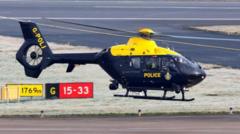Could a Police Helicopter and US Fighter Jet Have Collided?

A Close Encounter: Misidentifying a Fighter Jet as a Drone in Suffolk Skies
In an intriguing incident that highlights the complexities of modern air traffic management, a police helicopter operating around RAF Lakenheath in Suffolk reported a near miss with what they believed to be a drone. However, investigations revealed that the object in question was, in fact, a U.S. Air Force F-15 Eagle fighter jet. This event raises important questions about air safety, the identification of flying objects, and the communication protocols in place between military and civilian aviation. In this article, we will explore the details surrounding this incident, the implications it has for air traffic safety, and the broader context of drone sightings in the region.
The Incident: A Timeline of Events
On the evening of November 22, the National Police Air Service (NPAS) helicopter was dispatched to the area surrounding RAF Lakenheath due to multiple reports of unmanned aerial vehicles (UAVs) in the vicinity. As the helicopter entered the airspace near Lakenheath, the crew observed flashing red lights, which they initially interpreted as the signals from a drone.
Key Details of the Encounter
- Misidentification: The NPAS crew believed they were tracking a drone approaching their flight path.
- Altitude Proximity: The two aircraft came within 1,900 feet (approximately 579 meters) of each other.
- Risk Assessment: The helicopter pilot assessed the risk of a collision as "medium."
- Lack of Communication: The helicopter crew was not informed of the F-15's presence by RAF Lakenheath, which complicated situational awareness.
- Technology Limitations: The helicopter’s traffic collision avoidance system failed to detect the F-15.
Understanding the Misidentification
Investigators from the UK Airprox Board, which reviews near-miss incidents, concluded that the flashing lights observed by the helicopter crew belonged to the F-15 Eagle. The confusion underscores a critical issue in identifying aerial objects—especially at night. Factors contributing to this misidentification include:
Factors Leading to Misidentification
- Light Confusion: In low-light conditions, lights from various aircraft, planets, or even satellite constellations like Starlink can easily be mistaken for drones.
- Situational Awareness: The lack of prior notification from air traffic control regarding the F-15's location diminished the helicopter crew's situational awareness.
- Technological Gaps: Existing traffic collision avoidance systems may not always correctly identify military aircraft, which often operate under different protocols.
The Role of Air Traffic Control
The incident has raised questions about the effectiveness of communication between military bases and civilian air operations. The RAF Lakenheath approach controller was aware of the F-15’s position but did not convey this information to the NPAS helicopter crew. This lack of communication could have potentially prevented the misunderstanding that led to the near miss.
Importance of Reciprocal Traffic Information
Providing reciprocal traffic information is crucial for ensuring the safety of both military and civilian aircraft. In this case, had the helicopter crew received timely updates about the F-15's operations, they could have adjusted their flight path and avoided the perceived risk.
The Broader Context of Drone Sightings
The area around RAF Lakenheath has been the subject of numerous reports regarding drone sightings. These incidents have prompted not only police action but also investigations by the Ministry of Defence Police. The frequent identification of drones in the vicinity of military installations raises significant security and safety concerns.
Public Perception and Drone Regulations
As drones become more common, public understanding and perceptions of them are critical. Many individuals may not differentiate between drones and other types of aircraft, leading to panic or misreporting. Current regulations governing drone use are evolving, but the increasing presence of drones has led to calls for more stringent guidelines and better public education on the matter.
The Response from Authorities
In light of the incident, various authorities have issued statements reinforcing their commitment to air safety. The NPAS acknowledged the professionalism and sound judgment of its crew, while the U.S. Air Force confirmed compliance with UK air traffic control regulations during the operation.
Official Statements
- Ch Supt Vicki White: Expressed confidence in the crew’s decision-making process, noting that they acted on the belief of observing drone operations.
- USAF Statement: Emphasized that they maintained proper vertical separation distances and complied with all regulations.
Lessons Learned and Future Implications
This incident serves as a critical learning opportunity for both military and civilian aviation sectors. Several key takeaways emerge from the event:
Key Takeaways
- Enhanced Communication: Improving communication protocols between military and civilian air traffic control is essential for preventing similar incidents in the future.
- Public Awareness Campaigns: Educating the public about drones and their operational regulations can help mitigate misunderstandings and false reports.
- Technological Improvements: Investing in advanced traffic collision avoidance systems that can accurately identify all types of aircraft, including military jets, is crucial.
FAQs
What happened in the near miss incident involving the police helicopter and the F-15 Eagle?
The police helicopter, responding to reports of drones, misidentified an F-15 Eagle fighter jet as a drone. The two aircraft came within 1,900 feet of each other, with the helicopter crew assessing the risk of collision as medium.
Why was the F-15 misidentified as a drone?
Factors such as low visibility, light confusion, and a lack of prior communication from air traffic control contributed to the misidentification of the F-15 as a drone.
What is being done to prevent similar incidents in the future?
Authorities are focusing on enhancing communication protocols between military and civilian aviation, increasing public awareness about drone regulations, and improving technology for identifying various aircraft types.
Conclusion
The incident involving the NPAS helicopter and the F-15 Eagle fighter jet serves as a vital reminder of the complexities and challenges within modern airspace management. As drones continue to proliferate, ensuring clear communication and effective identification of aerial objects will be essential for maintaining safety in shared airspace. The lessons learned from this incident could pave the way for advancements in aviation safety protocols that benefit both military and civilian operations alike.
As we move forward in an increasingly crowded sky, how can we better ensure that misidentifications like this one do not happen again? Stay informed, and remember that every flight carries with it the responsibility of safe navigation and communication.
#AviationSafety #DroneRegulations #AirTrafficControl
Published: 2025-06-28 17:01:24 | Category: technology



